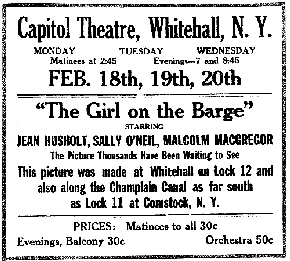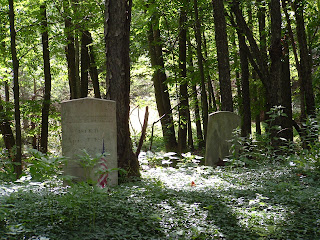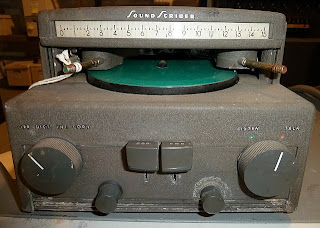 Following is the story of a movie that was filmed long ago on the barge canal in Whitehall, New York, where the canal links with Lake Champlain. The details were researched and written by my partner, Jill McKee, after following up on a recollection of her beloved elderly aunt, Mary Barber (now deceased). This fortunate collaboration led to the addition of an exhibit in Whitehall’s Skenesborough Museum. In 1929, Universal Pictures released a film called The Girl on the Barge. The movie was about Erie McCadden, the illiterate daughter of a crusty, alcoholic barge captain. Erie falls in love with Fogarty, the pilot of the tugboat that is towing her father’s barge from New York to Buffalo on the Erie Canal. Captain McCadden is not at all pleased when he discovers the romance, and his anger is escalated further by the fact that Fogarty is teaching Erie to read.
Following is the story of a movie that was filmed long ago on the barge canal in Whitehall, New York, where the canal links with Lake Champlain. The details were researched and written by my partner, Jill McKee, after following up on a recollection of her beloved elderly aunt, Mary Barber (now deceased). This fortunate collaboration led to the addition of an exhibit in Whitehall’s Skenesborough Museum. In 1929, Universal Pictures released a film called The Girl on the Barge. The movie was about Erie McCadden, the illiterate daughter of a crusty, alcoholic barge captain. Erie falls in love with Fogarty, the pilot of the tugboat that is towing her father’s barge from New York to Buffalo on the Erie Canal. Captain McCadden is not at all pleased when he discovers the romance, and his anger is escalated further by the fact that Fogarty is teaching Erie to read.
Happily, in the end the captain comes to his senses, likely due in no small part to Fogarty’s rescuing of McCadden’s barge when it is accidently set adrift. Erie marries her love and the two present McCadden with a grandson.The Erie Canal proved too difficult a setting for the Universal production department to create on or near the studio’s lot. However, the Erie Canal itself was not deemed suitable either. At least that was the opinion of the movie’s director, Edward Sloman, who came to New York State with two veteran cameramen, Jack Voshell and Jackson Rose, to find the right filming location.Such location trips were rare at that time in the movie industry, but Universal was willing to invest the added time and money necessary to film the movie in the correct setting. After scouting the entire modern, commercialized Erie Barge Canal from Albany to Buffalo, Sloman felt it would not be believable to audiences. “They would swear we faked it in California,” he said.Enter a contractor from Waterford, New York, named John E. Matton. He believed the Champlain Canal was just what Universal was looking for. After seeing it, Sloman agreed and chose Whitehall as the filming location.In May 1928, Sloman and rest of the film’s cast and crew set up their headquarters at Glens Falls and took up temporary residence at the Queensbury Hotel in order to begin making the movie. The silent era was giving way to “talkies,” and The Girl on the Barge was a hybrid between the two—a silent film with talking sequences.
The film’s cast was made up of some notable stars. The title role of Erie was played by Sally O’Neil, who had found stardom in 1925 when she appeared along with Constance Bennett and Joan Crawford in Sally, Irene, and Mary. Erie’s father, the barge captain, was played by Jean Hersholt, who appeared in 140 films from 1906–1955, and served as president of the Academy of Motion Picture Arts and Sciences from 1945–1949.Malcolm MacGregor (or McGregor), who appeared in over 50 films during his career, played Erie’s love interest, Fogarty. Erie’s sister, Superior McCadden, was played by Nancy Kelly, whose career spanned from the 1920s to the 1970s, during which time she received nominations for an Emmy and an Oscar, and also won a Tony Award. Both Ms. Kelly and Mr. Hersholt have stars on the Hollywood Walk of Fame.The movie’s director, Edward Sloman, was no slouch either. He directed nearly 100 films and acted in more than 30, with some producing and writing thrown in for good measure. The story on which the movie was based was originally written by Rupert Hughes for Cosmopolitan magazine. Mr. Hughes was a prolific writer who saw more than 50 of his stories and plays made into movies.The entire episode apparently caused quite a stir in the Whitehall/Glens Falls area. Several Whitehall residents took part in various scenes in the movie, and a humorous incident at the Queensbury Hotel was reported in the Syracuse Herald on June 11, 1928.It seems that Mr. Hersholt arrived at the hotel after a day of filming. He was still dressed as his drunken barge-captain character and asked for his room number without giving his name. The desk clerk not so politely informed Mr. Hersholt that the hotel was filled with “those motion picture people,” and there were no rooms available. In order to gain access to his room, Mr. Hersholt had to call upon director Edward Sloman to vouch for him.
Universal had a three-tiered rating system for its motion picture productions at the time Girl on the Barge was filmed. Low-budget flicks were dubbed Red Feather, and mainstream productions were labeled as Bluebird. The Girl on the Barge was categorized as one of Universal’s most prestigious films, called Jewel. Jewel productions were expected to draw the highest ticket sales.The movie was released on February 3, 1929. Various newspaper ads and articles have been found showing the movie still playing in theatres around the country into the following fall. The movie also received many favorable reviews. The Chronicle Telegram of Elyria, Ohio, complimented the “realistic and picturesque scenes” of “the barge canals of Upper New York State” (May 20, 1929).The New York Times reviewer, Mordaunt Hall, raved about Mr. Hersholt’s make-up and costume, and stated, “The scenes are admirably pictured.” The Sheboygan Press of Sheboygan, Wisconsin, called the film “an exceptional picture,” and went on to report, “The picture actually was photographed along the picturesque Champlain Ship Canal in Upper New York State.”Photos: Top?Movie Poster now on exhibit in the Whitehall Museum. Middle: Sally O’Neil and Malcolm MacGregor in a scene near the canal. Bottom: Movie advertisement in the Ticonderoga Sentinel, 1929.
Lawrence Gooley has authored eleven books and dozens of articles on the North Country’s past. He and his partner, Jill McKee, founded Bloated Toe Enterprises in 2004. Expanding their services in 2008, they have produced 22 titles to date, and are now offering web design. For information on book publishing, visit Bloated Toe Publishing.









